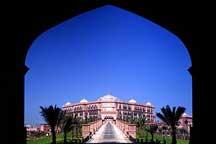 Apr. 4, 2025
Apr. 4, 2025
Weather
Pictures of Labrang Monastery
2009-06-01 15:18 BJT
BEIJING, May 5 -- The Labrang Monastery is one of the six great monasteries of the Geluk Sect (the Yellow Sect) of the Tibetan Buddhism. Considered to be in the traditional Tibetan area of Amdo, it is home to the largest number of monks outside of Tibet Autonomous Region.
The Labrang Monastery is located in Xiahe Township, Gannan Tibetan Autonomous Prefecture, northwest China's Gansu Province. The town is reflection of different ethnic groups that can be found in China, such as the Tibetans (about 70% of the population), the Hui Chinese (20%) and the Han Chinese (10%).

The Labrang Monastery is one of the six great monasteries of the Geluk Sect (the Yellow Sect) of the Tibetan Buddhism. It is considered to be home to the largest number of monks outside of Tibet Autonomous Region. (Source: china.org.cn)
Although the region is mostly rural and pastoral (including yak and other animal rearing), tourism is growing rapidly mainly due to the monastery.
The monastery was founded by Jamyang Zhaypa and Ngawang Tsondru in 1709. It is the Tibetan Buddhism‘s most important monastery outside the Tibetan Autonomous Region.
The monastery complex dominates the northern part of the village. The white walls and golden roofs feature a blend of Tibetan and Han architectural styles. The monastery contains 18 halls, six institutes of learning, a golden stupa, a sutra debate area, and houses nearly 60,000 sutras.
There once were more than 2000 monks in residence, but now only 500, due to a twelve-year closure starting in 1958. It has a Buddhist museum with a large collection of Buddha statues, sutras and murals. In addition, a large amount of Tibetan language books, including books on history,are available for purchase, together with medicines, calendars, music and art objects.

The Labrang Monastery is one of the six great monasteries of the Geluk Sect (the Yellow Sect) of the Tibetan Buddhism. It is considered home to the largest number of monks outside of Tibet Autonomous Region. (Source: china.org.cn)
The monastery today is an important place for Buddhist ceremonies and activities. From Jan. 4 to 17 and June 26 to July 15 (these dates may change according to the lunar calendar), the great Buddhist ceremony will be held with Buddha-unfolding, sutra enchanting, praying, sutra debates, etc.
The monks are extremely friendly to foreigners, and use every opportunity to practice their basic English which in most cases is self-taught. Accommodation is easy to find and a great variety of articles and souvenirs are available.
The Labrang Monastery historically situated itself at the strategic intersection of four major Asian cultures -- Tibetan, Mongolian, Han Chinese, and Chinese Muslim -- was one of the largest Buddhist monastic universities. In the early twentieth century, it housed several thousand monks.

The Labrang Monastery is one of the six great monasteries of the Geluk Sect (the Yellow Sect) of the Tibetan Buddhism. It is considered home to the largest number of monks outside of Tibet Autonomous Region. (Source: china.org.cn)
Labrang was also a gathering point for numerous annual religious festivals, supported an active regional marketplace where the Han Chinese artisans rubbed shoulders with the Hui merchants and the nomadic Tibetan highlanders. It was the seat of a Tibetan power base that strove to maintain regional autonomy through the shifting alliances and bloody conflicts that took place between 1700 and 1950.
Festivals:The most interesting periods to visit Labrang are during one of its annual festivals. By far the best event is Monlam, the Great Prayer Festival. It takes place sometime from February to early March (the exact dates vary because they are based on the Tibetan lunar calendar).
Editor: 卢佳颖 | Source: china.org.cn
 Mail
Mail Share
Share Print
Print


 Video
Video









 2009 China Central Television. All Rights Reserved
2009 China Central Television. All Rights Reserved